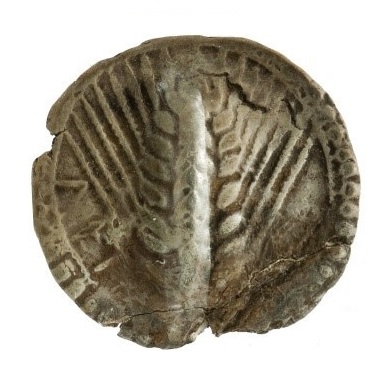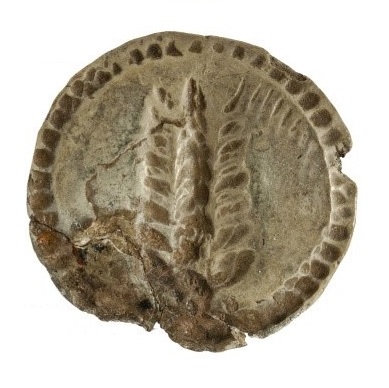Title: Stater of Metapontion - 1973.25
Acquisition number: 1973.25
Author or editor: Douglas Kelly
Culture or period: Archaic Greece.
Date: 530-500 BC.
Material: Metal - Silver
Object type: Coins - Greek
Dimensions: 28mm (w)
Origin region or location: Italy
Origin city: Metapontion
Display case or on loan: 5
Keywords: Coin, Greek, stater, Sicily, Magna Graecia
K.N. Rutter (ed.), Historia numorum: Italy (London, The British Museum, 2001), 1459.
Sylloge Nummorum Graecorum, Deutschland, München Staatlische Münzsammlung (Berlin, Hirmer Verlag, 1968-), 930.
1973.25
Stater of Metapontion
Silver 7.93 g. 28 mm. 530-500 BC
Obv.: Ear of barley. MET[A] (abbrev, for ΜΕΤΑΠΟΝΤΙΝΩΝ, ‘of the Metapontians’).
Rev.: Same type, incuse.
The name of the city of Metapontion was Romanized to Metapontum by the first century BC. The four Achaian colonies located along the ‘sole’ of South Italy, Kroton, Kaulonia, Metapontion and Sybaris, used a weight standard peculiar to them of a silver stater of c. 8 g. They also had their own individual minting technique, illustrated in this coin. The reverse die is an exact copy of the image of the obverse die but reproduces the obverse image in intaglio or incuse form. In this coin the barleycorn is raised in relief on the obverse and sunk in incuse form on the reverse, a difficult technique, especially with a thin flan; exact positioning of the two dies is needed when the coin is struck. Like the staters of Kroton (such as 1988.03), Metapontine staters became smaller and thicker over the period c. 550-450 BC (c. 500, 24mm diameter; c. 450, 20mm).
It is a common belief that the grain symbolizes agricultural prosperity, e.g., T. J. Dunbabin, The Western Greeks [1948], 87,but it needs to be explained why the image is an ear of barley, since barley is less nutritious and less palatable than wheat and, as the food of horses, slaves and the poor, was held in low esteem in classical antiquity.
K.N. Rutter (ed.), Historia numorum: Italy (London, The British Museum, 2001), 1459.
Sylloge Nummorum Graecorum, Deutschland, München Staatlische Münzsammlung (Berlin, Hirmer Verlag, 1968-), 930.

